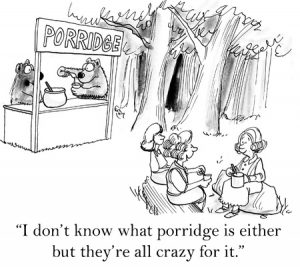
Oh dear ! You’ve just spent lots of money and resources improving a much loved product. The product goes out to the consumer in a great fanfare – “Now its better” you say. The next you see are unpleasant, disappointed Twitter comments about how this much loved product has been mucked about with. It doesn’t look the same, doesn’t taste the same etc. etc. All that effort trying to meet what you thought your consumers wanted and it goes belly up ! All that money wasted and you are in a spiral trying to mollify your core customers.

Food disasters are very common especially when an iconic brand is altered, even tweaked. Consumers notice these things. Having been involved in product development for many years, I’ve personally witnessed what happens on social media when an ingredient is replaced or removed to meet the initial challenge. The change is made and suddenly it just doesn’t look right.
There are some classic cases out there and the list grows on. Colour is one of the worst to get right or wrong in the consumer’s mind. Artificial colours are often in the spotlight for safety and toxicity reasons. It seems a perfectly sensible idea to replace them with a colour that is natural, satisfies ‘green’ credentials, looks good and even better in the lab. It then gets launched and the product just doesn’t look right in the kitchen, bowl or glass. I don’t advocate going back to artificial colours but sometimes a natural replacement doesn’t pass muster.
Natural colours are not easy to handle in a recipe but there are some great ones to choose from. Turmeric and marigold for yellow and orange, algal greens and blues (think of Spirulina), fruit and black carrot anthocyanins for reds and purples are some of the best naturals. However, finding suitable substitutes doesn’t always work in a formulation. Natural colours are not as robust as we would like in product development. It is the case that an alternative is simply not as good as it could be, in which case either don’t make the change or if you have to, find out just how big an impact it will have with the consumer.
At FoodWrite Ltd we are always on the look out for new natural colours and flavours for our customer’s products. Incidentally, early consumer research shouldn’t be ignored as the first step. You need to know if the change is needed in the first place and there are a host of activities to be conducted with clear business objectives.
The key product development action is always to look at how robust the colour is in a process for the food under consideration. Seems odd to say perhaps but if it looked an exact replacement before cooking and then turns a ghastly brown, well forget it as a replacement. Having established some early rules for the new ingredient in a product, deciding on the appropriate levels to add becomes the next step. It can be the case that the food before cooking or processing might not look as good as it did before the change. In this case we examine how critical these aspects are in sensory research. Each situation is dealt with on a case by case basis but there are some basic ground rules to be observed. Love to know your thoughts on this type of product development activity by the way !
Postscript:
If you want to know more about what we can do for you in product development, especially replacing ingredients then contact FoodWrite Ltd. We treat each example on a case by case basis as no situation is exactly the same.


Nice piece. I’ve been doing product development for many years and the number of times and hours I’ve spent reworking mistakes caused by marketing wanting to change stuff is unbelievable. I wont name my old companies but you know from my Linkedin who I’m talking about. I think one of the worst was changing a colour from synthetic red which wasn’t dangerous at the levels used by the way to a synthetic which went brown as soon as look at it. Any heat and the whole lot looked like sludge. In the end we went back to the synthetic and no problem. The customer got what they wanted as well. Then we did it all over again with the same result, with a new marketing team. I reckoned I had a job for life just repeating the same work. Natural anthocyanins simply do not cut it in my book.
Product developers do suck at their job! I thought your work was not bad and I hear you are still going! Good luck to you. I’m retired now from this work and it really annoyed me when customers hadn’t a clue about what they wanted.